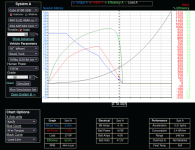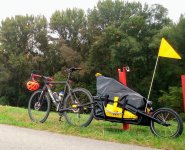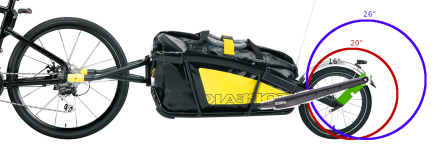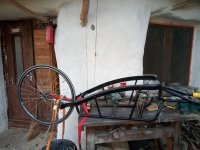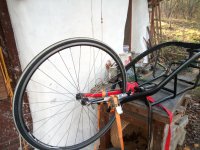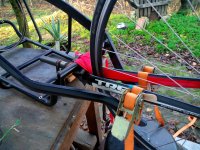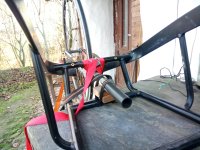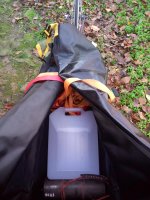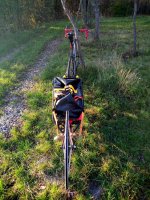Yes, the geared ones appear to be the best candidates now, but I'm still unsure which one is able to produce 150 W at 450 RPM without magnets flying off, and at what voltage, I need to educate myself more on this.
For outrunner style geared hubs, the magnets are the inside of the rotor and held in by the rotor bell, so they won't fly off. (inrunners with surface-mounted (SPM) magnets (instead of IPM) might have this problem). Most of the geared hubs I've seen are designed this way. If you're not sure of a specific motor, there are often teardowns here on ES for them.
A catch with high RPM on geared hubmotors is that the motor itself inside will be running at 5x or more the external RPM, some like the G310 with dual reductions maybe 10x or more, and if it also has a high pole count it may exceed the "ERPM" of most controllers, so they may not be able to run it at the speed you want. One post mentioning this:
https://endless-sphere.com/forums/viewtopic.php?f=3&t=96950&hilit=lightest#p1420515
If you're looking for the lightest geared hub, there's a few threads with some discussions about "lightest" hubmotors in this list, though many of them discuss DD hubs rather than geared, there are some mentions of geared hubs in there. Some of the info isn't useful because it's old enough the motors discussed are no longer made, though.
https://endless-sphere.com/forums/search.php?keywords=lightest&terms=all&author=&sc=1&sf=titleonly&sr=topics&sk=t&sd=d&st=0&ch=300&t=0&submit=Search
The bafang G310 might be the still-made winner; I haven't looked around much as small light motors don't really do me much good anymore.

Main thread about it (there's a bunch of threads discussing and using and modifying it
https://endless-sphere.com/forums/viewtopic.php?f=2&t=92124&hilit=g310
Simulator link for it:
http://www.ebikes.ca/tools/simulator.html?bopen=false&motor=MG310_STD&cont=cust_18_60_0.02_V&wheel=20i&mass=140&hp=0&grade=0&axis=mph&batt=B4814_EZ&blue=Lbs
There's also the Q series, Q70, 85, 100, 128 etc.
Dapu also makes some tiny ones, like the one I fixed here:
https://endless-sphere.com/forums/viewtopic.php?f=30&t=114480&hilit=dapu
No experience with any of them myself; the only geared hubs I've had were by Fusin (no longer around) which I broke the clutch on one with a "normal" cargo bike, and an old Ezee on my brother's trike that has had very little use so no real feedback on that one.
I used a trailer which attached to the seatpost, it was much worse.
That's pretty much why I never ended up building this one into a pusher:
https://endless-sphere.com/forums/viewtopic.php?f=2&t=21060&hilit=trailer
Clever solution! Have you posted pics of them?
This is the first MkIV version:
https://endless-sphere.com/forums/viewtopic.php?f=2&t=76539
at the end of the thread I added a second set of wheels just outboard of the first to handle the extra load of hauling a piano, and started a new thread for modifying it into an enclosed version with air conditioning for the dogs (and groceries if necessary) as the MkV, which hasn't been built yet (probably won't be anytime soon since the two dogs it was primarly for unexpectedly died last year; the one I have left doesn't go places):
https://endless-sphere.com/forums/viewtopic.php?f=2&t=94215&hilit=trailer#p1379480
Sounds great, is this a recumbent trike or more like a cargo trike? I'm really careful in turns passing between bollards on bike paths in the cities with my narrow but long trailer, I imagine with the wide wheelbase you really need to slow down every time.
Heavy cargo trike. Originally designed to carry Tiny (a small Saint Bernard) without having to use a trailer, and larger grocery or other cargo loads (without a trailer), it's usage and capabilities have been expanded over time, to where it could carry two very friendly Saints side by side, though this was almost never needed (usualy I'd just use the trailer for the second one when necessary).
It started out specifically narrow enough to fit thru a typical house front door, but at some point had to be widened a couple inches or so which means it might fit thru the doorway but only if the door swings all the way (180 degrees) out of the way, which mine don't (considered rehanging them on the other side...too many other issues that would cause). So the trike does fit within most bollards...but there are places it might not that I haven't been to in a while so am not sure. I know the big trailer won't; it's basically about 4 feet wide, maybe a bit more. :lol:
Original version here:
https://endless-sphere.com/forums/viewtopic.php?f=2&t=67833
which has evolved signifcantly over the years; this is almost the present version:
This is the thread for the new version, just concepts and working out ideas right now:
https://endless-sphere.com/forums/viewtopic.php?f=2&t=84161&hilit=cruiser
With the most recent possible concept here:
